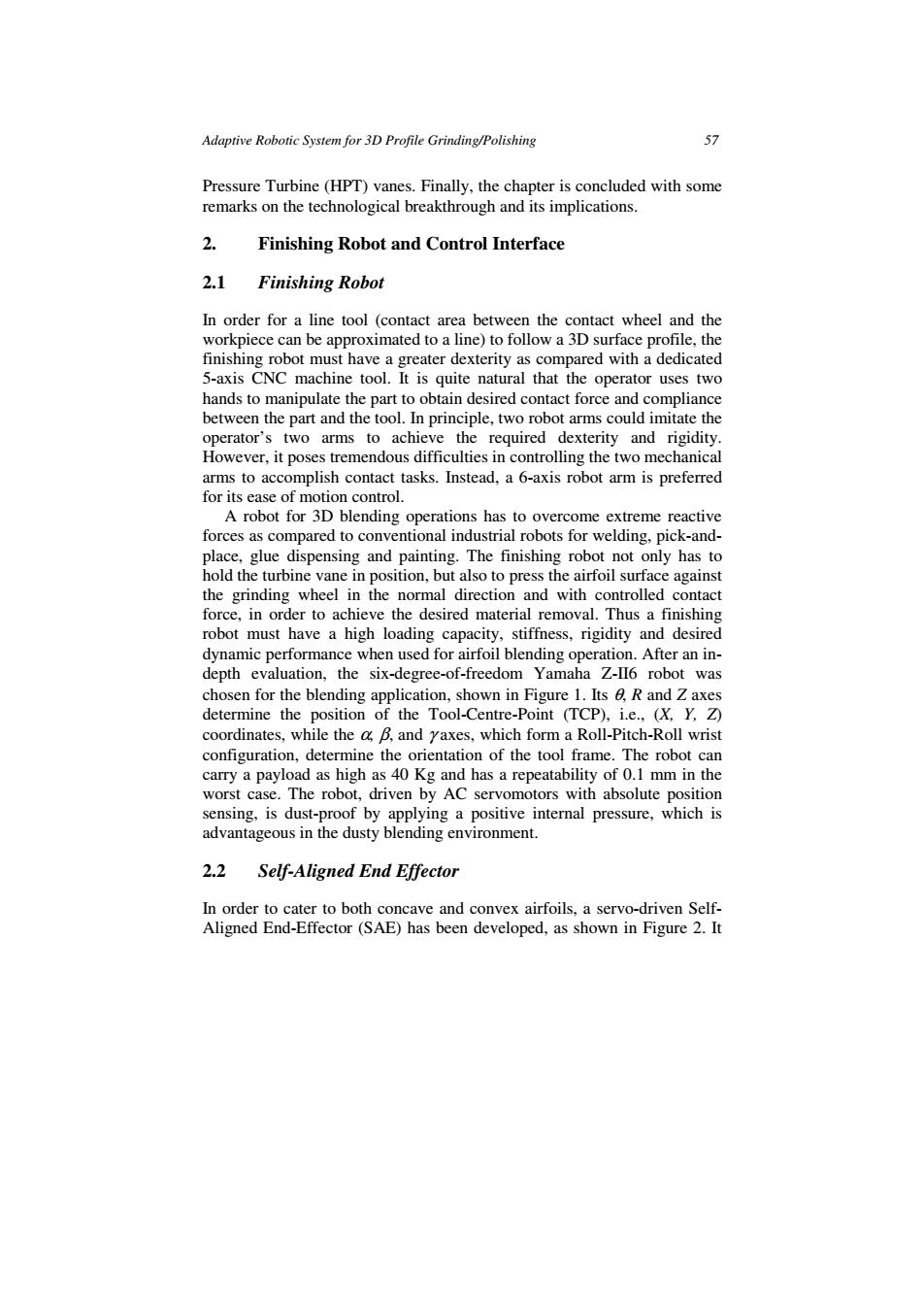正在加载图片...

Adaptive Robotic System for 3D Profile Grinding/Polishing 57 Pressure Turbine (HPT)vanes.Finally,the chapter is concluded with some remarks on the technological breakthrough and its implications. 2. Finishing Robot and Control Interface 2.1 Finishing Robot In order for a line tool (contact area between the contact wheel and the workpiece can be approximated to a line)to follow a 3D surface profile,the finishing robot must have a greater dexterity as compared with a dedicated 5-axis CNC machine tool.It is quite natural that the operator uses two hands to manipulate the part to obtain desired contact force and compliance between the part and the tool.In principle,two robot arms could imitate the operator's two arms to achieve the required dexterity and rigidity. However,it poses tremendous difficulties in controlling the two mechanical arms to accomplish contact tasks.Instead,a 6-axis robot arm is preferred for its ease of motion control. A robot for 3D blending operations has to overcome extreme reactive forces as compared to conventional industrial robots for welding,pick-and- place,glue dispensing and painting.The finishing robot not only has to hold the turbine vane in position,but also to press the airfoil surface against the grinding wheel in the normal direction and with controlled contact force,in order to achieve the desired material removal.Thus a finishing robot must have a high loading capacity,stiffness,rigidity and desired dynamic performance when used for airfoil blending operation.After an in- depth evaluation,the six-degree-of-freedom Yamaha Z-II6 robot was chosen for the blending application,shown in Figure 1.Its R and Z axes determine the position of the Tool-Centre-Point (TCP),i.e.,(X,Y,Z) coordinates,while the a B,and yaxes,which form a Roll-Pitch-Roll wrist configuration,determine the orientation of the tool frame.The robot can carry a payload as high as 40 Kg and has a repeatability of 0.1 mm in the worst case.The robot,driven by AC servomotors with absolute position sensing,is dust-proof by applying a positive internal pressure,which is advantageous in the dusty blending environment. 2.2 Self-Aligned End Effector In order to cater to both concave and convex airfoils,a servo-driven Self- Aligned End-Effector(SAE)has been developed,as shown in Figure 2.ItAdaptive Robotic System for 3D Profile Grinding/Polishing 57 Pressure Turbine (HPT) vanes. Finally, the chapter is concluded with some remarks on the technological breakthrough and its implications. 2. Finishing Robot and Control Interface 2.1 Finishing Robot In order for a line tool (contact area between the contact wheel and the workpiece can be approximated to a line) to follow a 3D surface profile, the finishing robot must have a greater dexterity as compared with a dedicated 5-axis CNC machine tool. It is quite natural that the operator uses two hands to manipulate the part to obtain desired contact force and compliance between the part and the tool. In principle, two robot arms could imitate the operator’s two arms to achieve the required dexterity and rigidity. However, it poses tremendous difficulties in controlling the two mechanical arms to accomplish contact tasks. Instead, a 6-axis robot arm is preferred for its ease of motion control. A robot for 3D blending operations has to overcome extreme reactive forces as compared to conventional industrial robots for welding, pick-andplace, glue dispensing and painting. The finishing robot not only has to hold the turbine vane in position, but also to press the airfoil surface against the grinding wheel in the normal direction and with controlled contact force, in order to achieve the desired material removal. Thus a finishing robot must have a high loading capacity, stiffness, rigidity and desired dynamic performance when used for airfoil blending operation. After an indepth evaluation, the six-degree-of-freedom Yamaha Z-II6 robot was chosen for the blending application, shown in Figure 1. Its θ, R and Z axes determine the position of the Tool-Centre-Point (TCP), i.e., (X, Y, Z) coordinates, while the α, β, and γ axes, which form a Roll-Pitch-Roll wrist configuration, determine the orientation of the tool frame. The robot can carry a payload as high as 40 Kg and has a repeatability of 0.1 mm in the worst case. The robot, driven by AC servomotors with absolute position sensing, is dust-proof by applying a positive internal pressure, which is advantageous in the dusty blending environment. 2.2 Self-Aligned End Effector In order to cater to both concave and convex airfoils, a servo-driven SelfAligned End-Effector (SAE) has been developed, as shown in Figure 2. It